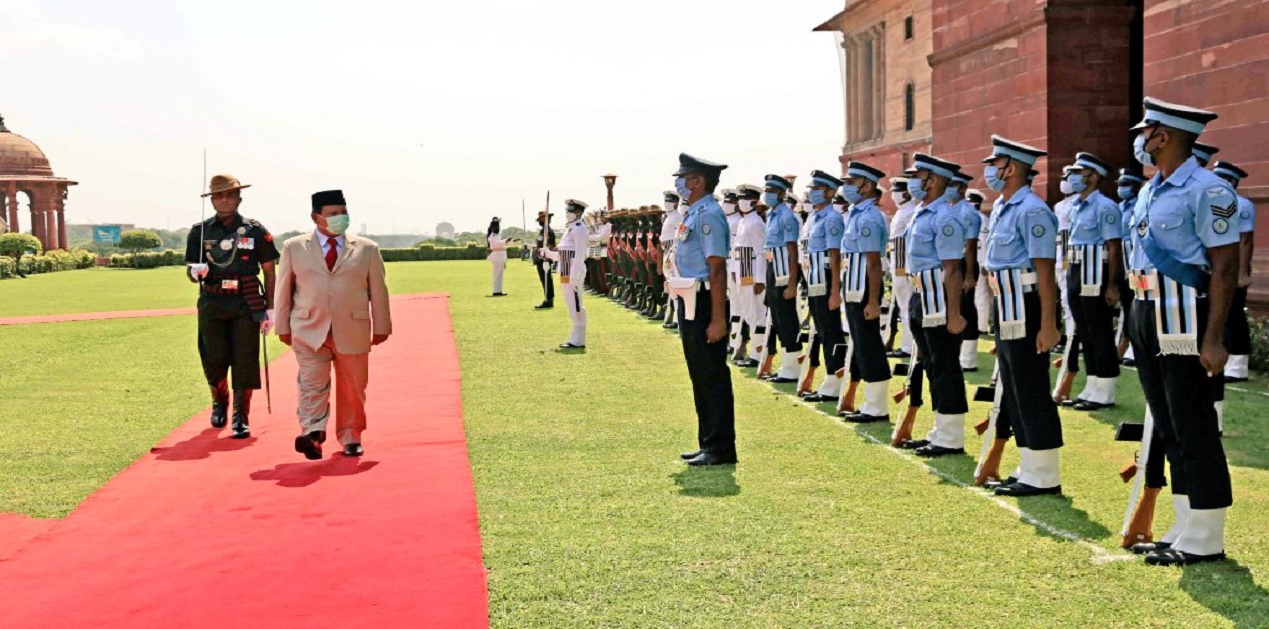The defence minister of Indonesia, General Prabowo Subianto was on a three day-visit to India from 26-28 July. The meeting was aimed at strengthening bilateral defence relationship. Two years ago, both countries elevated their relationship to a comprehensive strategic relationship. Prabowo Subianto’s primary interest in this visit would have been to initiate some armament deals. Just before flying to India, the minister was in Turkey, possibly to ink deals on drones and fighter jets. Indonesia has been in the process of modernising its armed forces since the past few years.
Indonesia’s Security Challenges
Indonesia is an archipelagic nation with a huge territorial expanse of 5150 kms from East to West. It has 17,508 islands. It also strides between the Indian Ocean and the Pacific Ocean, and the most critical chokepoints of this region- the straits of Malacca, Sunda and Lombok pass through its territory. Hence Indonesia is strategically significant in regional geopolitics. As an archipelagic country, it faces both traditional and non-traditional security challenges. Many of the non-traditional challenges such as piracy, armed robbery at sea have been managed well through regional multilateral mechanisms such as the Malacca Strait Patrol with its neighbours Singapore and Malaysia. Indonesia has so far also tackled the challenge of terrorism well.
The biggest conflict in the region of Southeast Asia is the South China Sea conflict, but Indonesia is not part of the territorial dispute. So, it was not at loggerheads with China unlike the other claimants like Vietnam or the Philippines. However, since the past few years Indonesia has started to feel the heat of increasing Chinese aggression. Indonesia and China are clashing at the Natuna- a group of islands north-east of Sumatra, and west of Borneo.
The Natuna Sea dispute is not new, China had published a map way back in 1993 when it had shown Natuna islands as part of its territory. However, in the recent times, China has demonstrated its aggression. The Chinese fishing vessels, with the support of Chinese Coast Guardhave been intruding Indonesia’s exclusive economic zone (EEZ) in the Natuna sea and indulging in illegal fishing. In 2016 there was a major incident in the Natuna and, earlier this year Chinese fishing vessels chased away Indonesian fishermen. Indonesia has reacted fairly strongly, be it seizing and burning the Chinese fishing vessels, or President Joko Widodo’s visit to Natuna in January 2020 where he held cabinet meeting on a warship, or military deployment. But generally, Indonesia had chosen to downplay these matters.
A few weeks ago Indonesia conducted a four-day military exercise with sea and land components. A part of this exercise was conducted at northern edge of Indonesia’s EEZ that borders China’s nine-dash line.
Indonesia seems resolute against Chinese expansionism. But it is careful about not antagonising China and seems to follow the path of quiet diplomacy. With the paradigm of the Indo-Pacific, Indonesia is going to become important for India, and also for the US. But as is with every Southeast Asian country, it would not choose sides. While New Delhi may be keen to have Jakarta into an expanded QUAD or QUAD-Plus as it is called, Jakarta is unlikely to be on board in the immediate future. It may however, deepen security partnership with QUAD members at a bilateral or even trilateral level, for example amongst India-Indonesia and Australia.
Indonesian military, like all other Southeast Asian forces has great asymmetry with the Peoples’ Liberation Army forces. Over that, Indonesia has faced problems with modernising its forces because of decades of sanctions from the West and, limited budget. Additionally, because of its military legacy, the country continues to remain focused on domestic threats. Despite being a maritime nation, Indonesian strategic perspective is still dominated by considerations of land defence. Over a period of many years, Indonesia’s Navy -called TNI-AL has been the worst hit where many of its platforms have overrun their lifespan. With increased Chinese aggression, which is only likely to intensify in the future, the policy makers in Indonesia are taking the China threat seriously. One of the ways is to enhance the TNI-AL’s capacity of law enforcement and its ability to safeguard its waters.
To speak of the navy specifically, the bulk of Indonesian naval surface platforms are from Netherlands with a few from UK and Germany. Its existing submarines were purchased from South Korea. Indonesia recently acquired C-130H Hercules aircraft from Australia1 towards its two new squadrons. Its combat aircrafts consists of F-16s, SU-30s and SU-27. Indonesia and China have agreement for joint-production of C-802 anti-ship cruise missiles and C-705 surface-to-surface missiles that are inducted on TNI-AL’s missile attack crafts2. A few fast attack crafts are produced locally. This year Indonesia announced mass production of medium-altitude, long-endurance UAVs called Elang Hitam to be done locally3.
This year in January the Ministry of Defence submitted a requirement of USD 10.6 billion (IDR 150 trillion) to the parliament; and if approved it would be the highest ever defence expenditure for the Indonesian armed forces. The funding priorities for 2021 are said to be procurement of ammunitions, naval vessels, modernising and replacement of aircrafts and also to complete existing projects and backlog4. But latest reports indicate that the military is yet again facing financial challenges due to COVID-19 induced economic slowdown and therefore might look at leasing equipment rather than purchasing. The government’s priority is economic recovery at the moment so some re-prioritising of defence equipment is likely.
Issues of Mutual Interest
India and Indonesia enjoy the long historical, cultural and civilisational ties. In May 2018 PM Modi visited Indonesia and both countries became comprehensive strategic partners. The thinking in New Delhi has been favourable for deeper engagement with Indonesia. Traditionally, both New Delhi and Jakarta maintained a policy of non-alignment. As the US-China relations have deteriorated, there is a fear of a new Cold War in the Indo-Pacific. Both India and Indonesia would want to avoid making an either-or choice. (However, the India-China dynamics since LAC are undergoing change.) Indonesia is in the very geographical space where US-China dynamics unfold. India’s unique position because of its foreign policy of strategic autonomy, makes it an important partner for Indonesia. ASEAN has had a policy of enmeshment and engagement with great powers to maintain regional security. India has emerged as a strong, non-binary partner of ASEAN. As US-China competition unfolds in Southeast Asia, presence of other extra-regional countries like India is sought as a balancing element.
The present visit- an actual visit amidst pandemic rather than a virtual one is quite important. General Prabowo described his visit on his Instagram in following words5:
“Conducting a Bilateral Visit to the Ministry of Defence of India. On this visit, the Minister of Defence of India HE Rajnath Singh discussed cooperation in the defence sector between the two countries, as well as programs that can be synergized to support the strategic logistical reserve program which is currently one of the main program of the President of the Republic of Indonesia, Ir. H. Joko Widodo’.
The details of the agenda or agreements were not made public. But on the basis of aforesaid factors, one can predict the purpose of the visit. Defence Minister General Subianto would like to have more Indian engagement- possibly joint-patrols. Also, he would have been interested to purchase some defence equipment, notably patrol crafts and coast guard vessels. Besides a general interest for joint defence production, some interest in airpower is likely, with strong intent for joint-development. It is also reported that sale of BrahMos missile is under consideration6. Prabowo has also discussed the ‘Logistical Reserve Programme’ of Indonesia, which he is heading, possibly as part of a plan to build food estate in Central Kalimantan, where India may make contribution as a major agricultural producer.7
Both sides would like to enhance coordination between their maritime agencies. Whether Indonesia wants India to join the Malacca Strait Patrols will have to be seen.
Indonesia has had a pattern where it entered into purchasing agreements but either had to cancel or postpone due to paucity of funds. Before his visit to India, Prabowo Subianto met with his trade ministry to discuss possibility of goods to export to India8. There is a strong possibility that some barter arrangement would be worked out in lieu of partial or actual payments. Indonesia has gone this way before in its defence purchases.
There has been some (rather sensational!) talk about India developing the strategic Sabang port but nothing has moved as yet. Earlier, the Indian media had wrongly reported Sabang as a potential base for the Indian Navy. Sabang is just about 90 nautical miles away from Indira Point so it hardy has any value as a military base. But it has great commercial possibility which needs to be recognised in India. India needs to be keen on developing the Sabang port to enhance connectivity between Andaman-Nicobar island (A&N) and Sabang to gain commercially. If the governments can allow for trade between Sumatra and A&N, costs of daily items and provisions will significantly reduce in A&N.
President Joko Widodo had launched a policy called Global Maritime Fulcrum (GMF) in 2014. Amongst maritime defence, security and safety, the GMF aimed at better maritime governance, domestic development through increased maritime commerce and, improve maritime infrastructure. Human resource development is also one of the pillars of GMF. The GMF has somewhat been on a backburner in Widodo’s second term; nonetheless it would be a good avenue for Indian companies to explore and invest.
While it is only natural to observe India-Indonesia relations through the prism of China, (even more so in the current environment), the leadership in both the countries is well aware that relationship has a lot of potential; independent of contemporary geopolitics.
Endnotes
- Abas, bin Marhalim , Indonesia receives final C-130H Hercules transport from Australia’, 17 February 2020, Janes URL: https://www.janes.com/defence-news/news-detail/indonesia-receives-final-c-130h-hercules-transport-from-australia (Accessed 2 August 2020)
- World Navies, IHS Jane’s, (2016), pp 255.
- ‘Indonesia to mass-produce drones’, New Straits Times, 10 February 2020.
- MacDonald, Andrew, ‘Covid-19: Indonesia signals potential major increase in defence spending’, 24 June 2020, Janes URL: https://www.janes.com/defence-news/news-detail/covid-19-indonesia-signals-potential-major-increase-in-defence-spending (Accessed 3 August 2020)
- Bukan Beli Rudal, Ternyata Prabowo ke India Ada Misi Jokowi’ CNBC Indonesia 29 July 2020. URL: https://www.cnbcindonesia.com/news/20200729074620-4-176129/bukan-beli-rudal-ternyata-prabowo-ke-india-ada-misi-jokowi (Accessed 15 August 2020) . Translated using Google.
- ‘India and Indonesia resolve to expand defence ties’27 July 2020, LiveMint, URL: https://www.livemint.com/news/world/india-and-indonesia-resolve-to-expand-defence-ties-11595855255356.html (Accessed 27 July 2020.)
- Op.cit.
- ‘Setelah ke Turki, Prabowo Terbang ke India, Ada Apa?’ CNBC Indonesia 25 July 2020. URL : https://www.cnbcindonesia.com/news/20200725083628-4-175324/setelah-ke-turki-prabowo-terbang-ke-india-ada-apa (Accessed 15 July 2020) . Translated using Google.
(The paper is the author’s individual scholastic articulation. The author certifies that the article/paper is original in content, unpublished and it has not been submitted for publication/web upload elsewhere, and that the facts and figures quoted are duly referenced, as needed, and are believed to be correct). (The paper does not necessarily represent the organisational stance... More >>
Image Source: https://pbs.twimg.com/media/Ed6aASlVoAELgu3?format=jpg&name=medium










Post new comment